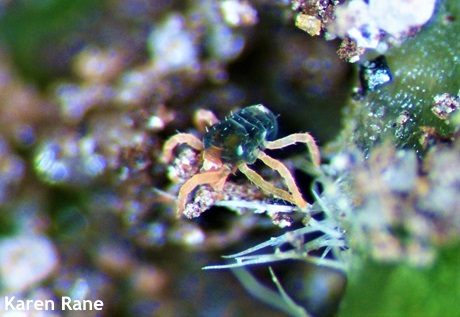Over the last three months a few early season high tunnel operations on the Eastern shore were having problems with some of their seedlings and leaf crops. Crops like spinach would have “whitening’”and then browning and eventually dead margins of their leaves while seedlings would collapse. We found the problem to be “red legged winter mites” Penthaleus dorsalis, which is a new pest in vegetables and herbs for us. This mite was identified by Ron Ochoa, USDA, Beltsville, Maryland. Because these mites are such new pests some of the information presented here is based on other closely related earth mite pest species.
Red legged winter mites thrive in what we would normally consider conditions too cold for an arthropod to cause problems. This mite is cold adjusted and cannot stand hot dry soil conditions and will die as summer heat approaches. Eggs are laid in late spring and they over-summer in the soil. These are stress resistant eggs (i.e., they can withstand drying and heat as well as synthetic chemical applications). In the fall they will begin to hatch, and mites will be active throughout the fall and winter inside a high tunnel with crops. Damage appears as ‘silvering’ or ‘whitening’ of the attacked foliage. Mites are most damaging to newly emerging crops, greatly reducing seedling survival and development.
Red legged winter mites are difficult to control even when using synthetic chemicals. Foliar sprays of pyrethroids (check label for the particular crops that are labeled as this will vary greatly) or Pyrethrum + Neem or Beauveria bassiana + Pyrethrum will reduce feeding, but if mite populations are high it will be difficult to eliminate the damage. Applications should start as soon as damage is noticed before mites have a chance to build their population. Foliage should be thoroughly covered with spray material as should the base of plants.
Cultural controls involve using transplants instead of direct seeding, as the mites would do less damage to larger plants. Using high levels of heat such as clear plastic mulch to heat the soil and kill mites and, if used in the summer, kill even their eggs. Steam heat used to control nematodes and soil pathogens can be used to greatly reduce mite numbers before next fall’s planting. Many cultivations during the summer can significantly decrease the number of over-summering eggs that survive.
– Jerry Brust, IPM Vegetable Specialist, University of Maryland
Photo above: Red legged winter mite Penthaleus dorsalis.















